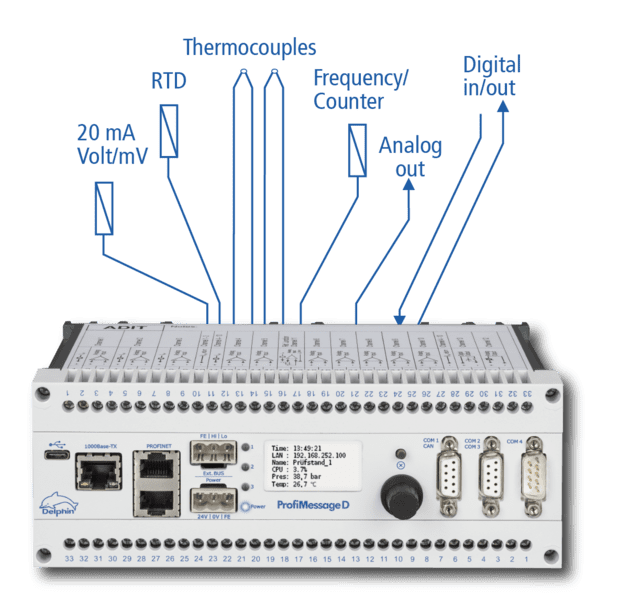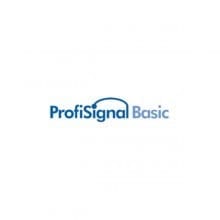Description
ProfiMessage D Data Acquisition System – Network Compatible and Modular
The Delphin ProfiMessage D Data Acquisition System is the next generation, Industry 4.0 modular data acquisition, monitoring, and control system. A master/slave design makes ProfiMessage D suitable for both small and large applications that require the processing of up to hundreds of channels. The ProfiMessage D incorporates a new OPC UA software interface which allows open data exchange to facilitate integration with other equipment and systems. It also features several other enhancements over the previous generation of ProfiMessage systems:
- Built-in display for monitoring and network configuration
- Two PROFIBUS interfaces (single or redundant)
- Optional WLAN interface
- Optional PROFINET interface
The ProfiMessage D has a modular master/slave design. Both the master and slave devices can accommodate two I/O modules. A single master can control up to 20 slaves allowing up to 660 I/O channels in a single system. There is a range of analog and digital I/O modules which allow the system to meet the requirements of all types of industrial DAQ applications. A network interface enables ProfiMessage devices to be integrated into a TCP network or to be directly connected to a PC workstation or laptop computer. Online measurement data can be transmitted, saved, and processed. The data can be stored simultaneously within the ProfiMessage D device itself.
Product Features
- Data acquisition and automation
- Data transmission via LAN (internet/intranet)
- Data storage capability for independent operation
- Modular and scalable
- Full potential isolation
- Universal inputs and outputs
- Control and automation functions
- Signal conditioning within the device
- Connection to external equipment and PLC control
- Configuration via PC
Universal Connectivity
ProfiMessage D’s universal inputs enable the connection of signals of any type including non-isolated signals. This means costly measurement transducers are usually not necessary. Potential isolation between channels as well as differential inputs saves both time and money.
Universal inputs enable any unit of measurement to be acquired (e.g. temperature, pressure flow, vibration, etc.). Data then undergoes direct scaling and linearization. Conversions from mA to bar or ml/min take place directly within the ProfiMessage D data acquisition system. High measurement precision is achieved through the use of 24-bit resolution Sigma-Delta converters and enables the connection of the smallest of signals (e.g. thermocouples).
Various Applications
- Multi-channel data acquisition
- Monitoring and alarm management
- Test stand automation
- Product testing
- Quality assurance
- Monitoring of buildings
Easy to configure
The configuration of the ProfiMessage D is done using a PC with the user-friendly DataService Configurator software. Configuration data is processed online and permanently within the devices. Optional integrated data memory up to 32 GB can locally store billions of measurement values.
The ProfiMessage D has an intelligent local controller which allows it to operate as a stand-alone device. This controller also provides many functions such as limits/alarms, calculations, logic, and other functions through software channels. This allows the system to be configured to meet the needs of many different types of applications without having to learn a complicated programming language.
Profisignal Software
The optional ProfiSignal software package is a Windows-based application available in three versions which provides a full range of capabilities from visualization and data archiving to fully automated test systems with report generation. Optional modules provide additional capabilities such as connecting to SQL databases, vibration analysis, or FDA CFR21 Part 11 compliance. The new ProfiSignal Web is a client/server application that allows platform-independent access to (remote) measurement projects from any standard web browser.
Modules
Master and Slaves
The ProfiMessage D series has 2 types of devices: masters and slaves. The master device contains the CPU unit and data storage capability. Salve devices serve as extensions to the master device. Each device can be equipped with 1 or 2 I/O modules.
The ProfiMessage master is connected via standard cabling with a TCP/IP network. Slave devices are connected to the master via a CAN bus. Any number of master devices can be connected into a network. A maximum of 1000 I/O channels can be processed within a master-slave system.
| Module |
Analog
Inputs |
Analog
Ouputs |
Frequency
Status Inputs |
Status
Inputs |
Switch
Outputs |
Sum
Sampling Rate |
| ADGT |
8 channels
Volt/mV, 20mA, RTD,thermocouples |
|
|
|
|
60 Hz |
| ADIT |
10 channels
Volt/mV, 20mA, RTD,
thermocouples |
1 channel
20mA |
|
|
1 channel |
600 Hz |
| ADVT |
15 channels
Volt/mV, 20mA,
thermocouples |
|
|
|
|
600 Hz |
| ADFT |
8 channels
Volt/mV, 20mA |
2 channels
0…10 V |
2 channels |
2 channels |
4 channels |
10 kHz |
| AMDT |
8 channels
Volt/mV, 20mA |
2 channels
0…10 V |
2 channels |
2 channels |
4 channels |
10…160 kHz |
| AAST |
4 channels
Volt/mV, 20mA, Pt100,
thermocouples |
4 channels
20mA |
|
2 channels |
2 channels |
600 Hz |
| IOIT |
|
|
|
24 channels |
1 channel |
|
| OTPT |
|
|
|
1 channel |
24 channels |
|
| DIOT |
|
|
11 channels |
1 channel |
16 channels |
|
Modular design
Each device (master or slave) can accommodate 2 different input/output modules. There are no restrictions in to which slots the modules are inserted. Sensors are connected via detachable clamps. For servicing, the rows of clamps can easily be removed by undoing 2 screws without having to disconnect any cabling.
Necessary steps for project planning:
- Create a list of analog and digital channels
- Allocate channels to modules
- Allocate modules to master and slave devices
Standard module measuring rate
Even with large numbers of channels the measuring rate is not affected by the number of input/output modules, with a maximum rate of 600Hz for standard modules. Each module is equipped with an A/D converter. A multiplexer consecutively connects each separate measurement channel.
Very precise measurement accuracy; resolution 24 bit; Autocalibration.
AMDT module features
- 8 channels for vibration and dynamic measuring
- ADFT for dynamic measuring in time domain signals
- AMDT/V for frequency and time domain signals. Simultaneous calculation of characteristic values
Interfaces
Connecting to the PC world via Ethernet
ProfiMessage D devices can be easily connected up to existing data networks. Large quantities of data can be transferred and accessed via PCs.
The ProfiMessage D master device (see illustration) is connected to the Ethernet using standard cabling. Practically any number of master devices can exist within a data network.
ProfiMessage D devices support current network functions:
- static IP addresses
- DHCP (Dynamic Host Name)
- FTP (reading data storage)
- http (internal web pages)
- SNTP (time synchronization)
- SMTP (sending emails)
OPC UA
The optional OPC UA Client/Server interface allows the ProfiMessage D series devices to send and receive measurement-data exchange at field level. Measurement data and threshold violations can be immediately transmitted to subsystems via OPC UA. The OPC UA interface also provides data exchange to PLC systems and connections to process management systems.
Connecting slaves via CAN-Bus
The ProfiMessage D master can be extended using slave devices. Slaves are connected to the master via a CAN bus. The CAN (Controller Area Network) is a serial bus system with good transfer properties over short distances. Its main benefits are its high levels of reliability and a set maximum waiting time for high priority messages. The CAN bus is therefore capable of real time processing. It has a transfer rate of 1Mbit/s (adjustable for long cable lines).
Connecting external devices via RS232/485 ports
The ProfiMessage D device is equipped with four independent serial ports which can be used for both the connecting up to PC software (bus manager) or external devices. They can be used for importing data (from weighing machines) or exporting data (display systems). Data exchange is configured via COMPORT (channels). The required interface parameters for the corresponding mode can be configured here. Industry standard protocols are also available such as Modbus RTU, Profibus DP Slave (optional) and Modbus LAN.
Connecting a PLC via Profibus or Profinet interface
A serial port can also be utilized as a Profibus DP slave port. The ProfiMessage D device can then read and write signals from a PLC device. At the same time values can be transmitted to the PLC – a 2-way link exists between the PLC and ProfiMessage D device. The optional PROFINET interface supports different topologies, e.g. ring and line while adhering to the CC-B conformance class.
Data transmission via telephone and radio telecommunications
ProfiMessage D does not differentiate between data networks and external data transmission. This means all functions available for network processing are also available for external data transmission. Because data can be stored locally within a Message device, uninterrupted data transmission to a central server, at low telephone costs, can be performed without the need for any PC support. Using the internet can further reduce costs. In the event of a malfunction an immediate warning is issued with the automatic sending by email of fault messages and fault occurrences.
Event log with pre and post history
Events and scenarios can be configured into the system. Malfunction messages can be allocated to these events with data and pre and post history being saved. Switch outputs can also be set enabling the production of warnings and alarms. In network environments emails can also be issued.
Vibration
Made possible by state-of-the-art DSP technology
The AMDT/V module in the ProfiMessage D system provides vibration analysis and monitoring in one system. ProfiMessage’s D modular system enables the simultaneous monitoring of both machine vibration and process values such as temperature and pressure.
Module AMDT/V – technical specifications
Potential isolation
Potential isolation of the entire module and analog circuit board
Additional optical isolation of digital input and outputs and CAN interface
Analog inputs
8 analog inputs, measuring range +/-25V / +/-10V / +/-2.5V /+/-1V,
14 bit resolution, synchronous sampling,
Maximum sampling rate 200KHz (4 channels at 50KHz, or 8 channels at 25KHz),
Anti-Alias-Filter, type 10 KHz
Analog outputs
2 analog outputs, 10 V voltage range, 14 bit resolution
Digital inputs
4 digital inputs, galvanic isolated, low-level 0..1.5V, high-level 3.5..90V,
2 with frequency counters, max. 100 KHz
Digital outputs
4 digital outputs, galvanic isolated, high-level max. 50V, 2.5A
Triggering and recording
- Triggering by time, analog or digital input
- Trigger threshold, edge, adjustable polarity
- Asynchronous or synchronous triggering (e.g. machine shaft reference impulse)
- Sampling frequency 1 Hz ..50 kHz with 4 channels or 25 kHz with 8 channels
- Recording density max. 8192 points per channel, max. 8 channels synchronous
- Adjustable pre-triggering within 0..100% range of recording density
Digital filters
- Filter types: low pass, band pass or high pass
- Filter ordering: 2..8, Butterworth characteristic, preselected
- Limit frequency 1 Hz ..10 kHz
- Filter adjustable and channel selective
- Time domain signal
- Averaging of time domain signals (in synchronous triggering)
- Variable data compression
FFT / frequency spectrum
- Flexible setting of frequency range, line numbers and resolution
- FFT algorithm for 256, 1024 or 4096 points with 100, 400 or 1600 lines respectively
- Choice of standard window functions ‘Hanning’, ‘Flat Top’, etc.
- Frequency spectra averaging
- Variable data compression
Vibration measurement values
- Flexible configuration via selection listValues available:
- Arithmetical average
- Peak to peak value
- TRMS values
- Main vibration amplitude/frequency
- Synchronous shaft vibration amplitude/phase position
- Dual synchronous shaft vibration amplitude/phase position
- Rotation
- Min-Max
- Evaluation of frequency wave
Monitoring
- Threshold value graphs (support procedure) to monitor “time domain signal/frequency spectrum” threshold values
- Threshold values for “vibration measurement value” monitoring
- Configurable digital outputs for “warnings” and “alarms”
- Configurable windows for machine speeds
Software
ProfiSignal Software
The configuration of ProfiMessage done with the included software “Data Service Configurator/Device Configurator”. The representation of the channels is clear and intuitive operation , similar to Windows Explorer. Double-click on a channel will open a configuration dialog in which all channel properties can be adjusted. The individual configuration files are stored in XML format in the ProfiMessage equipment and can be alternatively edited with an XML editor offline.
All measured values can be transferred online stores and will work on PCs or servers. The visualization or analysis is done with the ProfiSignal software dolphin or OPC Server with any software. This provides the ProfiSignal software in combination with a conventional device TopMessage up to 1000 times higher time resolution than a SCADA system.
In addition ProfiSignal as universal software for data acquisition, test automation and data acquisition applications. The range of application ranging from simple data storage and visualization to a complete automation solution with reporting.
Go with the three different versions, Basic and clicks ProfiSignal is suitable scaleable.
ProfiSignal Go – Software for data acquisition
ProfiSignal Basic – software for process visualization and monitoring
ProfiSignal Klicks – software for the automation of process and measurement procedures
ProfiMessage Software Channels
Monitoring and automation tasks can be realised using ProfiMessage software channels. Software channels are pre-defined function modules that users can generate and configure per mouse click and then subsequently run within the device. All functions are performed autonomously by the powerful internal processor. This guarantees full operational security for the ProfiMessage device.





